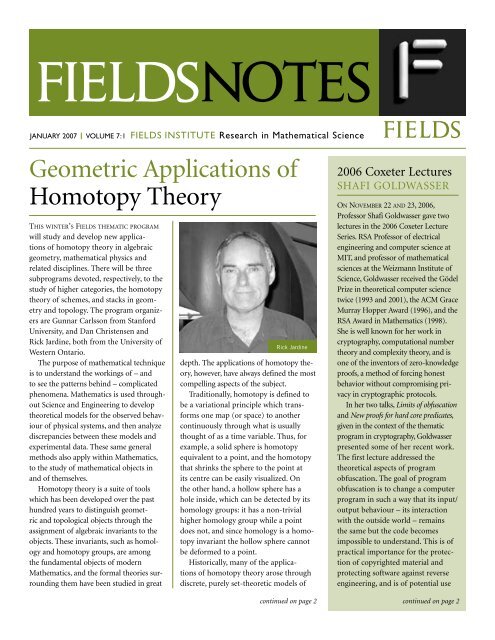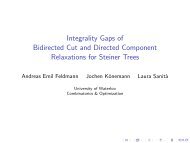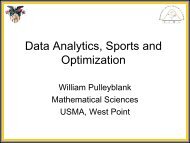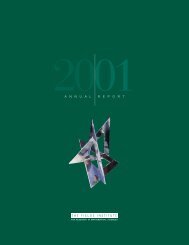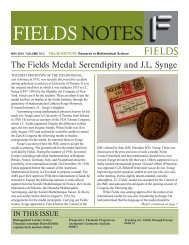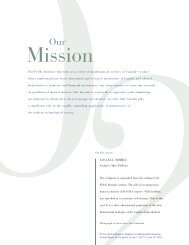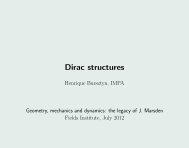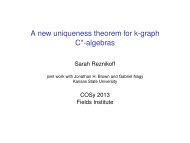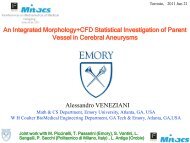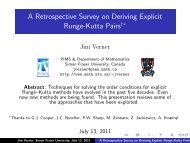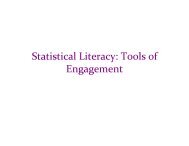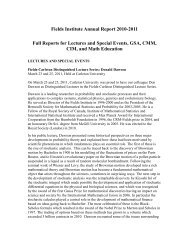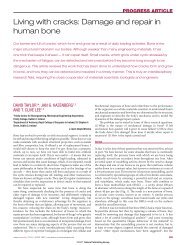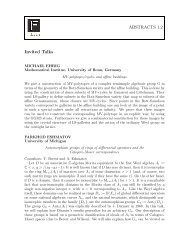FIELDS Geometric Applications of Homotopy Theory
FIELDS Geometric Applications of Homotopy Theory
FIELDS Geometric Applications of Homotopy Theory
Create successful ePaper yourself
Turn your PDF publications into a flip-book with our unique Google optimized e-Paper software.
<strong>FIELDS</strong>NOTES<br />
JANUARY 2007 I VOLUME 7:1 <strong>FIELDS</strong> INSTITUTE Research in Mathematical Science<br />
<strong>Geometric</strong> <strong>Applications</strong> <strong>of</strong><br />
<strong>Homotopy</strong> <strong>Theory</strong><br />
THIS WINTER’S <strong>FIELDS</strong> THEMATIC PROGRAM<br />
will study and develop new applications<br />
<strong>of</strong> homotopy theory in algebraic<br />
geometry, mathematical physics and<br />
related disciplines. There will be three<br />
subprograms devoted, respectively, to the<br />
study <strong>of</strong> higher categories, the homotopy<br />
theory <strong>of</strong> schemes, and stacks in geometry<br />
and topology. The program organizers<br />
are Gunnar Carlsson from Stanford<br />
University, and Dan Christensen and<br />
Rick Jardine, both from the University <strong>of</strong><br />
Western Ontario.<br />
The purpose <strong>of</strong> mathematical technique<br />
is to understand the workings <strong>of</strong> – and<br />
to see the patterns behind – complicated<br />
phenomena. Mathematics is used throughout<br />
Science and Engineering to develop<br />
theoretical models for the observed behaviour<br />
<strong>of</strong> physical systems, and then analyze<br />
discrepancies between these models and<br />
experimental data. These same general<br />
methods also apply within Mathematics,<br />
to the study <strong>of</strong> mathematical objects in<br />
and <strong>of</strong> themselves.<br />
<strong>Homotopy</strong> theory is a suite <strong>of</strong> tools<br />
which has been developed over the past<br />
hundred years to distinguish geometric<br />
and topological objects through the<br />
assignment <strong>of</strong> algebraic invariants to the<br />
objects. These invariants, such as homology<br />
and homotopy groups, are among<br />
the fundamental objects <strong>of</strong> modern<br />
Mathematics, and the formal theories surrounding<br />
them have been studied in great<br />
Rick Jardine<br />
depth. The applications <strong>of</strong> homotopy theory,<br />
however, have always defined the most<br />
compelling aspects <strong>of</strong> the subject.<br />
Traditionally, homotopy is defined to<br />
be a variational principle which transforms<br />
one map (or space) to another<br />
continuously through what is usually<br />
thought <strong>of</strong> as a time variable. Thus, for<br />
example, a solid sphere is homotopy<br />
equivalent to a point, and the homotopy<br />
that shrinks the sphere to the point at<br />
its centre can be easily visualized. On<br />
the other hand, a hollow sphere has a<br />
hole inside, which can be detected by its<br />
homology groups: it has a non-trivial<br />
higher homology group while a point<br />
does not, and since homology is a homotopy<br />
invariant the hollow sphere cannot<br />
be deformed to a point.<br />
Historically, many <strong>of</strong> the applications<br />
<strong>of</strong> homotopy theory arose through<br />
discrete, purely set-theoretic models <strong>of</strong><br />
continued on page 2<br />
<strong>FIELDS</strong><br />
2006 Coxeter Lectures<br />
SHAFI GOLDWASSER<br />
ON NOVEMBER 22 AND 23, 2006,<br />
Pr<strong>of</strong>essor Shafi Goldwasser gave two<br />
lectures in the 2006 Coxeter Lecture<br />
Series. RSA Pr<strong>of</strong>essor <strong>of</strong> electrical<br />
engineering and computer science at<br />
MIT, and pr<strong>of</strong>essor <strong>of</strong> mathematical<br />
sciences at the Weizmann Institute <strong>of</strong><br />
Science, Goldwasser received the Gödel<br />
Prize in theoretical computer science<br />
twice (1993 and 2001), the ACM Grace<br />
Murray Hopper Award (1996), and the<br />
RSA Award in Mathematics (1998).<br />
She is well known for her work in<br />
cryptography, computational number<br />
theory and complexity theory, and is<br />
one <strong>of</strong> the inventors <strong>of</strong> zero-knowledge<br />
pro<strong>of</strong>s, a method <strong>of</strong> forcing honest<br />
behavior without compromising privacy<br />
in cryptographic protocols.<br />
In her two talks, Limits <strong>of</strong> obfuscation<br />
and New pro<strong>of</strong>s for hard core predicates,<br />
given in the context <strong>of</strong> the thematic<br />
program in cryptography, Goldwasser<br />
presented some <strong>of</strong> her recent work.<br />
The first lecture addressed the<br />
theoretical aspects <strong>of</strong> program<br />
obfuscation. The goal <strong>of</strong> program<br />
obfuscation is to change a computer<br />
program in such a way that its input/<br />
output behaviour – its interaction<br />
with the outside world – remains<br />
the same but the code becomes<br />
impossible to understand. This is <strong>of</strong><br />
practical importance for the protection<br />
<strong>of</strong> copyrighted material and<br />
protecting s<strong>of</strong>tware against reverse<br />
engineering, and is <strong>of</strong> potential use<br />
continued on page 2
2006 Coxeter Lectures Shafi Goldwasser<br />
continued from page 1<br />
in cryptographic problems like computation<br />
on encrypted data – e.g. the tallying<br />
<strong>of</strong> electronic votes while preserving<br />
secrecy – and delegation <strong>of</strong> cryptographic<br />
ability. Goldwasser showed that the first<br />
proposed definition <strong>of</strong> what constitutes<br />
a good obfuscator could be weak in the<br />
context <strong>of</strong> multiple obfuscations. She<br />
introduced the concept <strong>of</strong> an obfuscator<br />
that is secure with regard to auxiliary<br />
output – extra information available to<br />
an attacker, possibly including the result<br />
<strong>of</strong> previous obfuscations. She then proved<br />
that there exist large families <strong>of</strong> natural<br />
functions that cannot possibly be obfuscated<br />
securely, no matter if the auxiliary<br />
input is independent or not <strong>of</strong> the function<br />
we would like to obfuscate (although<br />
the functions may be different in the two<br />
cases), showing that there are theoretical<br />
<strong>Geometric</strong> <strong>Applications</strong> <strong>of</strong> <strong>Homotopy</strong> <strong>Theory</strong><br />
continued from page 1<br />
spaces, such as simplicial complexes. But<br />
by the middle <strong>of</strong> the twentieth century it<br />
became clear that the models themselves<br />
determined an internal, purely combinatorial<br />
description <strong>of</strong> both homotopy and<br />
and homotopy theory. In other words,<br />
the homotopy invariants <strong>of</strong> a space are<br />
completely determined by its set <strong>of</strong> structureal<br />
elements, or simplices (or cells),<br />
and the incidence relations between them.<br />
The major early advances in this line <strong>of</strong><br />
thought were the introduction <strong>of</strong> singular<br />
homology theory by Eilenberg and Zilber<br />
in the 1940s, Kan’s development <strong>of</strong> the<br />
homotopy theory <strong>of</strong> simplicial sets in the<br />
1950s, and the axiomatic description <strong>of</strong><br />
homotopy theory given by Quillen with<br />
his introduction <strong>of</strong> closed model categories<br />
in the 1960s.<br />
This was a fundamental step forward for<br />
the subject and for its applications, because<br />
homotopy theory effectively became a<br />
combinatorial subject at this point. We<br />
now understand that homotopy theories<br />
<strong>of</strong> simplicial objects and model categories<br />
2 <strong>FIELDS</strong>NOTES | <strong>FIELDS</strong> INSTITUTE Research in Mathematical Science<br />
limits to what can be obfuscated.<br />
In her second lecture, Goldwasser<br />
presented an approach that can be used<br />
to prove that a function is a hardcore<br />
predicate. A predicate P (a function that<br />
returns “true” or “false”) is hardcore<br />
for a function f if computing P(x) better<br />
than a random guess is as hard as<br />
inverting f. Such a situation is essential<br />
for cryptographic one-way functions<br />
since they must be functions for which<br />
computing f(x) for a given x is relatively<br />
easy, but obtaining x only from the value<br />
<strong>of</strong> f(x) is computationally hard. For<br />
these functions, we are interested in segment<br />
predicates, i.e. predicates that can<br />
be transformed into a predication that<br />
changes value only polynomially many<br />
times in the bit size <strong>of</strong> x – for example<br />
“Is the k-th bit 1?” Using a number <strong>of</strong><br />
tools, ranging from coding theory to<br />
Fourier analysis, Goldwasser showed<br />
that any segment predicate is a hardcore<br />
are essentially device independent: they<br />
exist outside <strong>of</strong> the traditional confines <strong>of</strong><br />
topological spaces. <strong>Homotopy</strong> theory is<br />
a body <strong>of</strong> algebraic techniques that exists<br />
outside the realm <strong>of</strong> topological spaces.<br />
Furthermore, model categories and homotopy<br />
theories are pervasive in nature. It<br />
is easy and elementary, for example, for<br />
a student <strong>of</strong> the subject to re-organize all<br />
<strong>of</strong> homological algebra and the study <strong>of</strong><br />
derived categories in these terms.<br />
Simplicial structures exist throughout<br />
algebraic geometry, and homotopy types<br />
can be associated to geometric objects<br />
in many ways: Quillen’s introduction <strong>of</strong><br />
the higher algebraic K-theory <strong>of</strong> varieties<br />
was an early, very provocative example.<br />
The calculational difficulties associated<br />
to K-theory invariants led to a notion <strong>of</strong><br />
cohomological descent which was encoded<br />
first in etale homotopy types and etale<br />
K-theory, and then formalized in the<br />
homotopy theory <strong>of</strong> simplicial sheaves<br />
and presheaves. These theories are also<br />
the foundation for motivic homotopy<br />
theory, and as such have contributed to the<br />
major calculational successes <strong>of</strong> the last<br />
decade in algebraic K-theory: Voevodsky<br />
Andrew Klapper, Shafi Goldwasser, Juris Steprans,<br />
and Barbara Keyfitz<br />
predicate for three types <strong>of</strong> functions,<br />
namely those occurring in RSA encryption,<br />
finite field exponentiation and<br />
scalar multiplication <strong>of</strong> a point on an<br />
elliptic curve. The security <strong>of</strong> these three<br />
functions is essential to many cryptosystems,<br />
and this result was <strong>of</strong> great interest<br />
to many <strong>of</strong> the participants in the thematic<br />
program in cryptography.<br />
Nicolas Theriault (Fields Institute)<br />
first announced his pro<strong>of</strong> <strong>of</strong> the Milnor<br />
conjecture at a meeting at Fields in 1996.<br />
The ensuing transformation in algebraic<br />
K-theory has been so striking and fundamental<br />
that K-theory has morphed as a<br />
subject into something that we now call<br />
the homotopy theory <strong>of</strong> schemes.<br />
The homotopy theories <strong>of</strong> simplicial<br />
presheaves and presheaves <strong>of</strong> spectra are<br />
also widely applicable outside <strong>of</strong> K-theory.<br />
For example, every sheaf cohomology<br />
invariant is represented by a presheaf <strong>of</strong><br />
spectra in an appropriate stable homotopy<br />
category. Also, the homotopy theory <strong>of</strong><br />
simplicial presheaves is the right context<br />
for non-abelian cohomology theories, and<br />
for the theory <strong>of</strong> stacks and higher stacks.<br />
The theory <strong>of</strong> stacks is the modern<br />
theory <strong>of</strong> symmetries <strong>of</strong> geometric<br />
objects. Stacks have deep and important<br />
applications in a variety <strong>of</strong> disciplines.<br />
Examples in algebraic geometry include<br />
the Beilinson-Drinfeld approach to the<br />
geometric Langlands correspondence, and<br />
the algebraic geometric description <strong>of</strong><br />
the Gromov-Witten invariants. In recent<br />
years, presheaves <strong>of</strong> spectra on the stack<br />
<strong>of</strong> formal group laws have emerged in
Centre for Mathematical Medicine<br />
Colloquium Series Lecture: J.D. Murray<br />
FOR HOW MANY MATHEMATICIANS WILL A<br />
group <strong>of</strong> Undergraduate students charter<br />
a bus and drive over 100 kilometers<br />
to hear a lecture at Fields? The Waterloo<br />
Math Society organized a busload on<br />
October 20, 2006, at four dollars a head,<br />
to come to Fields for a talk by James<br />
Dickson (JD) Murray. Murray was actually<br />
on his way to receive an honourary<br />
DMath degree from Waterloo the next<br />
day. This was to add to his doctorate in<br />
Applied Mathematics at the University<br />
<strong>of</strong> St. Andrews (Scotland), and D.Sc. at<br />
Oxford. His citation mentions:<br />
Murray is a pioneer in the field<br />
<strong>of</strong> mathematical biology, including<br />
advances in the modeling<br />
and analysis <strong>of</strong> factors behind the<br />
spread <strong>of</strong> rabies. He has identified<br />
new areas <strong>of</strong> research in mathematical<br />
biology and his ideas have<br />
been applied to a number <strong>of</strong> pattern<br />
formation problems in developmental<br />
biology, wound healing<br />
and problems in modeling the<br />
growth <strong>of</strong> cancers.<br />
Murray has many other honours. He<br />
is also a Fellow <strong>of</strong> the Royal Society <strong>of</strong><br />
Edinburgh (FRSE) and a Fellow <strong>of</strong> the<br />
Royal Society (FRS). He stopped at Fields<br />
the introduction and development, in the<br />
hands <strong>of</strong> Hopkins and his collaborators,<br />
<strong>of</strong> elliptic cohomology theories and the<br />
theory <strong>of</strong> topological modular forms.<br />
Higher category theory concerns<br />
higher level notions <strong>of</strong> naturality, which<br />
can be expressed as maps between<br />
natural transformations, maps between<br />
such maps, and so on: that is, “maps<br />
between maps between maps ...” The<br />
need for a higher categorical language<br />
has become apparent, almost simultaneously,<br />
in mathematical physics, algebraic<br />
geometry, computer science, logic, and,<br />
to give a talk entitled On the Virtues <strong>of</strong><br />
Simple Models in the Biomedical Sciences,<br />
organized by the Centre for Mathematical<br />
Medicine.<br />
Murray is an author and coauthor <strong>of</strong><br />
many books including The Mathematics<br />
<strong>of</strong> Marriage: Dynamic Nonlinear Models,<br />
but he is especially known for his wonderful<br />
mathematical biology books. These<br />
introduce a reader with little formal training<br />
in biology to the practical application<br />
<strong>of</strong> mathematical models to help unravel<br />
the underlying mechanisms <strong>of</strong> biological<br />
processes. Many believe that biology will<br />
provide the inspiration for mathematics<br />
in this century that physics did a hundred<br />
years ago. Murray has helped lead the way.<br />
In his mathematical biology books, he<br />
introduces topics such as the mechanical<br />
theory <strong>of</strong> vascular network formation,<br />
geographic spread and control <strong>of</strong> epidemics,<br />
and wolf-deer interactions and deals<br />
with them with real mathematical tools<br />
such as differential equations. His models<br />
are based on genuine biological problems;<br />
his predictions and explanations result<br />
directly from a mathematical analysis <strong>of</strong><br />
the models.<br />
He talked first about the growth <strong>of</strong><br />
brain tumours, introducing a mathematical<br />
model <strong>of</strong> gliomas based on<br />
proliferation and diffusion rates. He<br />
<strong>of</strong> course, category theory itself. Such a<br />
language and a relevant body <strong>of</strong> results<br />
are already implicit throughout algebraic<br />
topology, where analogous higher<br />
homotopies have been in use since the<br />
1950s in the definition and analysis <strong>of</strong><br />
homotopy coherence problems. Many <strong>of</strong><br />
these developments have connections to<br />
physics, and to conformal and topological<br />
quantum field theory in particular.<br />
Similar ideas are present in new applications<br />
<strong>of</strong> homotopy theory in computer<br />
science, in models for concurrent<br />
behaviour <strong>of</strong> parallel processing systems,<br />
showed that one could simulate model<br />
tumours and achieve good agreement<br />
with clinically observed tumour geometries<br />
and suggested paths <strong>of</strong> tumour<br />
invasion not detectable on MRI images.<br />
This gives insight into microscopic invasion<br />
<strong>of</strong> the human brain by glioma cells<br />
and predicts pathways <strong>of</strong> glioma cell<br />
invasion. Hence one identifies regions<br />
<strong>of</strong> the brain where treatments should be<br />
focused.<br />
In predicting marriage stability and<br />
divorce he showed how to quantify a 15minute<br />
discussion <strong>of</strong> a topic <strong>of</strong> the couple’s<br />
choice and then apply the measured<br />
results. Based on a longitudinal study <strong>of</strong> a<br />
large number <strong>of</strong> newlywed couples, it was<br />
found that there was a 94 per cent accuracy<br />
<strong>of</strong> prediction <strong>of</strong> marital stability. The<br />
testers score anger and active listening<br />
and other factors to build a model whose<br />
scores have remarkable social predictive<br />
potential.<br />
The best thing about Murray’s talk was<br />
that the listeners easily understood the<br />
models and examples. He promised to<br />
keep the models simple, but not the applications,<br />
and he delivered. This listener left<br />
with the determination to read at least<br />
one <strong>of</strong> his books.<br />
Irwin Pressman (Carleton)<br />
computational geometry, and complexity.<br />
<strong>Homotopy</strong> theory also has subtle applications<br />
in combinatorics – for example in<br />
analysis <strong>of</strong> hyperplane arrangements, and<br />
in problems related to graph colouring.<br />
The algebraic, combinatorial nature <strong>of</strong><br />
modern homotopy theory is the basis <strong>of</strong><br />
its applications, and the subject and its<br />
techniques have become ubiquitous. It<br />
is also increasingly apparent that the full<br />
scale <strong>of</strong> the utility <strong>of</strong> homotopy theoretic<br />
ideas has yet to be discovered.<br />
Rick Jardine (Western)<br />
<strong>FIELDS</strong> INSTITUTE Research in Mathematical Science | <strong>FIELDS</strong>NOTES 3
Graduate Information Day 2006<br />
THE SERIES OF GRAD DAY EVENTS HAS BEEN<br />
organized by the Fields Institute for the<br />
past several years to provide local (and<br />
sometimes not so local) universities the<br />
opportunity to tell undergraduates planning<br />
to go to graduate school about their<br />
programs. This year’s event, held on<br />
Saturday, November 18, 2006, attracted<br />
over thirty students, the largest contingent<br />
being from Waterloo, but with Western,<br />
York and Toronto also being well represented.<br />
The list <strong>of</strong> departments that set up<br />
booths included the Mathematics departments<br />
from Carleton, Ottawa, Waterloo,<br />
Western, Manitoba, Guelph, OUIT as well<br />
as York’s Computer Science department.<br />
There were booths from both McMaster’s<br />
Computational Engineering department<br />
and its Mathematics and Statistics departments<br />
while the University <strong>of</strong> Toronto<br />
had representatives from Mathematics,<br />
Statistics and Computer Science.<br />
The booths were all set up by just after<br />
noon and students had plenty <strong>of</strong> time<br />
to talk to representatives. An interesting<br />
phenomenon observed was that students<br />
seemed reluctant to approach the representative<br />
tables individually, preferring,<br />
rather, to move from stand to stand collectively.<br />
A satisfactory explanation for<br />
this behaviour remains to be found.<br />
At 1:00 Renate Scheidler gave an<br />
interesting and accessible talk about the<br />
history <strong>of</strong> cryptography – as we learned,<br />
the more accurate way to refer to the<br />
subject is cryptology, which combines the<br />
encryption <strong>of</strong> data (cryptography) and its<br />
decryption (cryptanalysis).<br />
The most common type <strong>of</strong> encryption<br />
historically was the “shift cipher”, where<br />
each letter is replaced by the letter which<br />
appears K letters later in the alphabet.<br />
As an example she mentioned that HAL<br />
<strong>of</strong> 2001:A Space Odyssey fame, when<br />
encrypted with K = 1, is IBM. K = 3 was<br />
used by Julius Caesar and became known<br />
as the “Caesar Cipher”.<br />
Another kind <strong>of</strong> encryption widely used<br />
historically was the “transposition cipher”,<br />
4 <strong>FIELDS</strong>NOTES | <strong>FIELDS</strong> INSTITUTE Research in Mathematical Science<br />
in which the letters are scrambled. Both<br />
this and the shift cipher can be broken easily<br />
by a computer using statistical methods.<br />
In order to make these historical ciphers<br />
more secure, the two methods were at one<br />
time used in succession many times.<br />
Perhaps one <strong>of</strong> the best known encryption<br />
systems was Enigma, invented in<br />
Poland by A. Scherbius in the 1920s, and<br />
widely used by Germany in World War II.<br />
It had actually been broken in the 1930s<br />
by 3 Poles, M. Rejewski, H. Zygalski, J.<br />
Rózyski, and then once more by British<br />
mathematicians during the war – among<br />
them W.T. Tutte and Alan Turing.<br />
Another <strong>of</strong> the difficulties with encryption/decryption<br />
is the safe transmission <strong>of</strong><br />
the “key”. There are two solutions to this<br />
problem – Public Key Cryptography and<br />
Key Establishment Protocols.<br />
“ Renate Scheidler<br />
gave an interesting<br />
and accessible talk<br />
about the history <strong>of</strong><br />
cryptography”<br />
In Public Key Cryptography, the fictional<br />
sender, Alice, has both a public and<br />
a private key. The public key can be used<br />
by anyone to send her an encrypted message<br />
which can only be easily deciphered<br />
with the private key. This is accomplished<br />
by basing the keys on a mathematical<br />
problem which is (at least perceived to<br />
be) very difficult to solve. This method<br />
was invented by two Americans W. Diffie<br />
and M. Hellman in 1976 – but then it was<br />
later discovered that they had been anticipated<br />
a few years earlier by J. Ellis in the<br />
U.K. The most widely used system based<br />
on this idea is RSA – introduced by 3 MIT<br />
students Rivest, Shamir and Adleman in<br />
1978, and relies on the difficulty <strong>of</strong> finding<br />
the prime factors <strong>of</strong> large integers.<br />
The RSA method is rather slow and is<br />
now more <strong>of</strong>ten used to exchange cryptographic<br />
keys for the more traditional<br />
methods <strong>of</strong> encryption, such as AES.<br />
More recently elliptic curve cryptography<br />
(ECC) has come into widespread<br />
use, using the group law on elliptic curves.<br />
And other sophisticated methods involving<br />
number theory and such things as<br />
algebraic geometry and cohomology are<br />
also coming into use.<br />
Another important application <strong>of</strong><br />
cryptography is the digital signature,<br />
which makes authentication possible<br />
within electronic communication. In this<br />
case, in order to “sign” a message “m”,<br />
Alice sends both “m” and an encrypted<br />
version “s” obtained by using her private<br />
key. Then Bob can verify that “m” really<br />
came from Alice by using her public key to<br />
decrypt s. In algebraic terms, this means<br />
that decryption must be a right inverse as<br />
well as a left inverse to encryption (if we<br />
think <strong>of</strong> the operations being written on<br />
the left).<br />
Scheidler finished by talking about<br />
more futuristic methods, namely quantum<br />
cryptography and quantum information<br />
science. The former is based on the<br />
laws <strong>of</strong> physics, rather than mathematical<br />
problems, and is already in use. The latter<br />
– quantum information science – designs<br />
techniques for breaking public key cryptosystems<br />
and would break any public<br />
key cryptosystem currently in use. But its<br />
practical implementation is apparently<br />
not in sight.<br />
After the talk there was pizza and a<br />
chance for students to talk further with<br />
the graduate department representatives.<br />
It was close to 4:00 by the time the last<br />
booth was packed up and Grad Day 2006<br />
came to an end – a successful end, we<br />
believe.<br />
Carl Riehm and Juris Steprans<br />
(Fields Institute)
CRM-Fields-PIMS Prize Lecture 2006:<br />
Nicole Tomczak-Jaegermann<br />
THE FIRST RECIPIENT OF THE CRM-<strong>FIELDS</strong>-<br />
PIMS Prize, Nicole Tomczak-Jaegermann,<br />
gave her prize lecture at the Institute on<br />
November 20. The prize is the successor to<br />
the CRM-Fields Prize and is now supported<br />
by all three institutes. Several <strong>of</strong> those honoured<br />
by the earlier prize were in attendance<br />
to listen to Tomczak-Jaegermann’s lecture<br />
entitled, High dimensional convex bodies:<br />
phenomena, intuitions and results.<br />
The starting point <strong>of</strong> the talk was the<br />
concentration <strong>of</strong> measure phenomenon<br />
which is familiar from instances such as the<br />
law <strong>of</strong> large numbers or the concentration<br />
<strong>of</strong> the uniform measure <strong>of</strong> the large dimensional<br />
sphere near the equator. This sort<br />
<strong>of</strong> phenomenon presents a more sophisticated<br />
face in Dvoretzky’s theorem which,<br />
loosely speaking, says that each centered<br />
convex body <strong>of</strong> sufficiently high dimension<br />
has a central section <strong>of</strong> reasonably large<br />
dimension. A variation due to V. Milman<br />
gives bounds on the numbers involved:<br />
“ each centered<br />
convex body <strong>of</strong><br />
sufficiently high<br />
dimension has a<br />
central section <strong>of</strong><br />
reasonably large<br />
dimension."<br />
Every normed space <strong>of</strong> dimension n has an<br />
almost Euclidean subspace <strong>of</strong> dimension k<br />
> c˙log(n) for some constant c. The notion<br />
<strong>of</strong> almost Euclidean depends on the Banach-<br />
Mazur distance between two subsets <strong>of</strong> a<br />
linear space: Roughly speaking A and B are<br />
a distance apart if A can be moved so that<br />
it is sandwiched between B and B.<br />
The general nature <strong>of</strong><br />
the questions considered<br />
by Tomczak-Jaegermann<br />
is whether a given property<br />
is ubiquitous in<br />
sufficiently high dimensions.<br />
A space may fail<br />
to have the property for<br />
trivial reasons, but it<br />
may still be the case that<br />
many subspaces do have<br />
the property. For example,<br />
a property may be<br />
destroyed by multiplying<br />
with a small factor but<br />
the product will still have a large subspace<br />
with the desired property. In this context the<br />
notion <strong>of</strong> saturation is introduced: A space<br />
V is said to saturate the space X (with respect<br />
to a given integer n) if every subspace <strong>of</strong> X<br />
<strong>of</strong> dimension at least n contains a copy <strong>of</strong> V.<br />
Work <strong>of</strong> Tomczak-Jaegermann and Szarek<br />
shows that any space can saturate some<br />
space with respect to a suitable n.<br />
In the same circle <strong>of</strong> ideas is the problem<br />
<strong>of</strong> reconstruction <strong>of</strong> a vector from random<br />
measurements. Given a subset T <strong>of</strong> n-dimensional<br />
Euclidean space and k random vectors<br />
X i , where k is much smaller than n, if one<br />
knows the inner product <strong>of</strong> a vector t from<br />
T with each X i can one determine t? Earlier<br />
work <strong>of</strong> Candes and Tao on T being the<br />
unit ball in powers <strong>of</strong> l 1 inspired Tomczak-<br />
Jaegermann, Mendelson and Pajor to extend<br />
these results to other geometric structures<br />
and different probability distributions. The<br />
concentration <strong>of</strong> measure phenomenon<br />
plays a central role in their analysis <strong>of</strong> this<br />
class <strong>of</strong> problems. A related question that<br />
yields to this sort <strong>of</strong> analysis is that <strong>of</strong> exactly<br />
reconstructing a sparse matrix from random<br />
measurements. The surprising result is that<br />
this can be done if k > Crlog(n/r) where n is<br />
the length <strong>of</strong> the vector, r the number <strong>of</strong> nonzero<br />
coordinates, k the number <strong>of</strong> random<br />
measurements and C is a suitable constant.<br />
A polytope is called m-neighbourly if<br />
any m <strong>of</strong> its vertices is the vertex set <strong>of</strong><br />
Hugh Williams<br />
some face. If n vectors consisting <strong>of</strong> 1’s and<br />
-1’s are chosen at random in k-dimensional<br />
Euclidean space then they are almost certain<br />
to be m-neighbourly provided that<br />
mlog(Cn/k) < ck for constants C and c.<br />
The last part <strong>of</strong> the talk dealt with metric<br />
entropy. This concept deals with the packing<br />
and covering number familiar from geometric<br />
measure theory. The covering number<br />
N(K,B) is the least number <strong>of</strong> translations<br />
<strong>of</strong> B required to cover K while the packing<br />
number M(K,B) is largest number <strong>of</strong><br />
disjoint translations <strong>of</strong> B by elements in K.<br />
These numbers can be used to associate to<br />
each operator on a linear space a sequence<br />
<strong>of</strong> entropy numbers and, in the case <strong>of</strong> a<br />
compact operator U, the limiting behaviour<br />
<strong>of</strong> the entropy sequence <strong>of</strong> U is the same<br />
as that for U * . The Duality Conjecture<br />
<strong>of</strong> Pietsch asks whether the rates <strong>of</strong> convergence<br />
<strong>of</strong> the two sequences <strong>of</strong> entropy<br />
numbers are similar. Tomczak-Jaegermann<br />
introduced a convexified version <strong>of</strong> these<br />
numbers that, unlike the classical case, is<br />
sensitive to the ordering. These ideas were<br />
used to amplify earlier results on the Duality<br />
Conjecture.<br />
The selection <strong>of</strong> results provided a<br />
fascinating insight into the problems and<br />
methods, as well as the potential applications,<br />
<strong>of</strong> the study <strong>of</strong> asymptotic geometric<br />
analysis.<br />
Juris Steprans (Fields Institute)<br />
<strong>FIELDS</strong> INSTITUTE Research in Mathematical Science | <strong>FIELDS</strong>NOTES 5
First Canadian-Ukrainian Summer School<br />
THE PARTICIPANTS IN THIS SUMMER SCHOOL,<br />
that took place from August 14-26, 2006,<br />
were eight Ukrainian undergraduate students<br />
selected from the two largest mathematical<br />
centres in Ukraine, Kyiv and<br />
Kharkiv, Canadian students from local<br />
universities, and several postdocs and visitors<br />
to the Institute. All <strong>of</strong> the instructors<br />
were from the University <strong>of</strong> Toronto.<br />
We were very pleased with the results<br />
<strong>of</strong> the School and excited by the mathematical<br />
level <strong>of</strong> the participants. The<br />
School centered on dynamical systems:<br />
two mini-courses were given by the<br />
organizers, complemented by two beautiful<br />
lectures by G. Forni. Y. Karshon<br />
and B. Khesin introduced the students<br />
to symplectic geometry, motivating it<br />
by Hamiltonian dynamics. D.Bar Natan<br />
taught the students to tie some very<br />
sophisticated knots, as a motivation<br />
for the introduction <strong>of</strong> the polynomial<br />
knot invariants. I. Binder and J. Quastel<br />
THIS WAS THE THIRD IN A SERIES OF FOUR<br />
workshops representing part <strong>of</strong> the<br />
activities <strong>of</strong> the Thematic Program in<br />
Cryptography held at the Fields Institute<br />
during the fall <strong>of</strong> 2006 and it took place<br />
from October 30-November 3, 2006.<br />
Number theoretic problems lie at the<br />
heart <strong>of</strong> most public key cryptosystems in<br />
use today. The underlying idea is to base<br />
the security <strong>of</strong> such a cryptographic technique<br />
on a problem from number theory<br />
or arithmetic geometry that is widely<br />
believed (though generally not proved)<br />
to be extremely difficult. The only way<br />
an adversary knows how to break such<br />
a scheme is to solve an instance <strong>of</strong> this<br />
hard problem. The challenges faced by<br />
researchers who design and analyze such<br />
systems are both mathematical and computational<br />
in nature.<br />
Twenty-six speakers from institutions<br />
spanning eight different countries pre-<br />
6 <strong>FIELDS</strong>NOTES | <strong>FIELDS</strong> INSTITUTE Research in Mathematical Science<br />
Canadian-Ukrainian Summer School participants<br />
described a probabilistic approach to<br />
dynamics in their lectures, and introduced<br />
the students to such hot subjects as SLE,<br />
and stochastic PDEs. K. Murty gave an<br />
excursion into the mind <strong>of</strong> Pierre Fermat,<br />
at the time that he made the famous note<br />
on the margins which became known<br />
as the Fermat’s Last Theorem. He also<br />
described several fascinating open questions<br />
related to the theory <strong>of</strong> elliptic<br />
curves, and tempted the students with<br />
a Clay one million dollar problem – the<br />
sented state <strong>of</strong> the art research on a wide<br />
variety <strong>of</strong> subjects in computational number<br />
theory and cryptology. Not surprisingly,<br />
elliptic curves and other algebraic<br />
curves <strong>of</strong> low genus featured prominently,<br />
since curve-based cryptography is a very<br />
active area <strong>of</strong> research that also has commercial<br />
applications. Other topics included<br />
constructive questions in algebraic<br />
number fields and function fields, prime<br />
generating sequences, efficient matrix<br />
computations, factoring sparse polynomials,<br />
signature schemes, provable security,<br />
and public key cryptosystems based on<br />
lattices, tori and multivariate polynomials.<br />
The workshop schedule left ample<br />
time for informal meetings and research<br />
discussions. Social activities included a<br />
reception for all participants at Fields as<br />
well as a conference banquet.<br />
A special feature <strong>of</strong> the event was an<br />
informal presentation by Hugh Williams<br />
Birch and Swinnerton-Dyer Conjecture.<br />
On a lighter note, there was a pizza<br />
party at the Institute at which the students<br />
mingled with the lecturers, and<br />
a trip to Niagara Falls was, <strong>of</strong> course,<br />
included in the program.<br />
We see the School as a promising start,<br />
and hope that it will become a regular<br />
event at the Institute.<br />
It is a pleasure to acknowledge the<br />
generosity <strong>of</strong> the sponsors who made<br />
the Summer School possible: the<br />
Fields Institute; the Department <strong>of</strong><br />
Mathematics at the University <strong>of</strong> Toronto;<br />
the Department <strong>of</strong> Mathematics and<br />
Computational Sciences at the University<br />
<strong>of</strong> Toronto at Mississauga; and Aerosvit<br />
Ukranian Airlines. The School was also<br />
partially supported by contributions from<br />
several individual NSERC grants.<br />
Konstantin Khanin and<br />
Michael Yampolsky (Toronto)<br />
Workshop on Computational Challenges Arising in<br />
Algorithmic Number <strong>Theory</strong> and Cryptography<br />
Ukraine-Canada Summer School Students:<br />
Elena Usoltseva and Varvara Shepelska<br />
entitled My reminiscences <strong>of</strong> Emma<br />
Lehmer. Together with her late husband<br />
Dick Lehmer as well as Dick’s late father<br />
(and Emma’s supervisor) Derrick Lehmer,<br />
Emma was one <strong>of</strong> the early pioneers<br />
in the field <strong>of</strong> computational number<br />
theory. Still in good health, she celebrated<br />
her 100th birthday on November 6 in<br />
Berkeley, California.<br />
Renate Scheidler (Calgary)
Workshop on How I Became a Quant: Financial Engineers<br />
Give a Personal View <strong>of</strong> their Careers in Quantitative Finance<br />
IN THE EVENING OF OCTOBER 17, 2006,<br />
the Fields Institute hosted over 120<br />
students and industry participants for the<br />
successful event How I Became a Quant,<br />
organized by the International Association<br />
<strong>of</strong> Financial Engineers (IAFE) and<br />
sponsored by Numerix, a leading s<strong>of</strong>tware<br />
provider in cross asset derivatives pricing.<br />
Financial engineering is a relatively<br />
new discipline dedicated to providing<br />
and implementing practical solutions<br />
to economic and financial problems,<br />
which result from the social interactions<br />
<strong>of</strong> humans, rather than problems that<br />
originate in physics, chemistry or biology.<br />
Essentially, financial engineering can be<br />
seen as a cross-disciplinary field which<br />
relies on mathematical finance, numerical<br />
methods and computer simulations to<br />
make trading, hedging, investment and<br />
business decisions, as well as to facilitate<br />
the risk management <strong>of</strong> those decisions.<br />
Its application today extends well beyond<br />
traditional trading and financial markets<br />
into commercial and retail banking,<br />
commodities, portfolio management,<br />
insurance, and environmental problems,<br />
as well as corporate investment decisions<br />
and project planning in general.<br />
The recent explosive growth in<br />
quantitative finance has led mathematics,<br />
physics, computer science and engineering<br />
students <strong>of</strong> all levels to wonder whether<br />
a career or an advanced degree in<br />
quantitative finance is right for them.<br />
With the rapid increase in sophisticated<br />
quantitative and computational<br />
techniques employed in financial firms<br />
there has been increasing demand<br />
for students with highly quantitative<br />
backgrounds to work in the financial<br />
field and an increase in advanced degree<br />
programs covering these topics.<br />
Organized by the IAFE Education<br />
Committee and the Fischer Black<br />
Memorial Foundation, the “How I<br />
became a Quant” series are panel<br />
discussions for students interested in<br />
a career in quantitative finance. These<br />
events have been previously held in New<br />
York, London, Berkeley and Boston. The<br />
Toronto event was moderated by John<br />
Hull, the Maple Financial Group Pr<strong>of</strong>essor<br />
<strong>of</strong> Derivatives and Risk Management at<br />
the University <strong>of</strong> Toronto and IAFE Senior<br />
Fellow. Featured panelists included Barry<br />
Schachter, Chief Risk <strong>of</strong>ficer <strong>of</strong> Moore<br />
Capital Research, Jonathan Schachter,<br />
Vice President Financial Engineering<br />
at Numerix (both from NY) and<br />
Michael Zerbs, President and COO <strong>of</strong><br />
Algorithmics in Toronto.<br />
This type <strong>of</strong> forum is designed to<br />
give a personal view <strong>of</strong> the world <strong>of</strong><br />
quantitative finance from the point<br />
<strong>of</strong> view <strong>of</strong> pr<strong>of</strong>essionals with varying<br />
specialties. Without formulas or Power<br />
Point presentations, the panelists shared<br />
their own experiences and engaged in<br />
a moderated discussion with plenty <strong>of</strong><br />
student questions. Finally, as part <strong>of</strong><br />
the event, a reception for students and<br />
panelists was held after the panel. The<br />
Fields Institute is now well established as<br />
an important catalyst for bringing together<br />
academics, practitioners and students in<br />
quantitative finance with events such as the<br />
prestigious Quantitative Finance seminar<br />
series now running for over a decade, as<br />
well as the PRMIA Risk Management<br />
Seminars and courses. The great attendance<br />
and success <strong>of</strong> “How I became a Quant”<br />
further demonstrate the growth and<br />
interest in this field as well as the vital role<br />
that the institute continues to play.<br />
Dan Rosen (R2 Financial Technologies Inc.)<br />
WORKSHOP ON ELLIPTIC CURVE CRYPTOGRAPHY (ECC 2006)<br />
HELD AT THE INSTITUTE ON SEPTEMBER 18–20,<br />
2006, was the 10 th Workshop on Elliptic<br />
Curve Cryptography, an annual event that<br />
has been held since 1997. This year’s event<br />
was organized by Mark Bauer (Calgary),<br />
Tanja Lange (Eindhoven), Alfred Menezes<br />
(Waterloo), Kumar Murty (Toronto),<br />
Christ<strong>of</strong> Paar (Bochum), and Scott Vanstone<br />
(Waterloo). The purpose <strong>of</strong> the first workshop<br />
was to encourage the study <strong>of</strong> the elliptic<br />
curve discrete logarithm problem, whose<br />
hardness is the basis for the security <strong>of</strong> elliptic<br />
curve public-key cryptosystems.<br />
Over the years, the workshop has<br />
broadened its scope to cover all issues<br />
related to curve-based cryptography<br />
including the discrete logarithm problem,<br />
efficient curve arithmetic, efficient<br />
parameter generation, protocols, side-<br />
channel attacks, and deployment.<br />
At ECC 2006 there were lectures<br />
on three topics that are actively being<br />
researched: algorithms for the discrete<br />
logarithm problem, the security and<br />
efficiency <strong>of</strong> hyperelliptic curve cryptosystems,<br />
and pairing-based cryptography.<br />
For the first time, L(1/3) subexponentialtime<br />
algorithms were presented for the<br />
discrete logarithm problem in the<br />
Jacobians <strong>of</strong> certain classes <strong>of</strong> algebraic<br />
curves. State-<strong>of</strong>-the-art implementations<br />
<strong>of</strong> the arithmetic on genus-two hyperelliptic<br />
curves were described, showing<br />
that low-genus hyperelliptic curve cryptosystems<br />
are indeed competitive (and in<br />
some cases better than) their elliptic curve<br />
counterparts. Attendees were kept abreast<br />
<strong>of</strong> the latest techniques for generating<br />
low-embedding elliptic curves that are<br />
crucial for pairing-based cryptosystems,<br />
and the fastest method for implementing<br />
the Tate pairing. Several new research<br />
directions were considered, including the<br />
use <strong>of</strong> generalized Jacobians in cryptography,<br />
and the use <strong>of</strong> isogenies between<br />
supersingular elliptic curves to design<br />
provably-secure hash functions.<br />
ECC 2006 was attended by 107<br />
researchers and graduate students. There<br />
were 18 invited lectures, and a rump session<br />
consisting <strong>of</strong> short (and humourous)<br />
presentations about recent results and<br />
work in progress.<br />
ECC 2007 will be held from September 5-<br />
7 2007 at University College Dublin.<br />
Alfred Menezes (Waterloo)<br />
<strong>FIELDS</strong> INSTITUTE Research in Mathematical Science | <strong>FIELDS</strong>NOTES 7
RCI Public Lecture – Jeffrey S. Rosenthal<br />
Jeffrey S. Rosenthal<br />
THE ROYAL CANADIAN INSTITUTE ORGA-<br />
NIZES weekly public lectures on topics<br />
from science and technology aimed at a<br />
general audience. The Fields Institute is<br />
pleased to be able to help organize some<br />
<strong>of</strong> the RCI lectures on topics related<br />
to mathematics. The latest <strong>of</strong> these<br />
was given by Jeffrey Rosenthal <strong>of</strong> the<br />
University <strong>of</strong> Toronto.<br />
By a happy coincidence, Rosenthal’a<br />
RCI lecture had been scheduled for the<br />
Sunday following a week in which he<br />
was <strong>of</strong>ten heard in the news, commenting<br />
on the probability that owners <strong>of</strong><br />
variety stores in Ontario would have won<br />
as many prizes as it turns out they have.<br />
The probability <strong>of</strong> this happy coincidence<br />
was not revealed in his talk, but many<br />
other probabilities were, and the closeto-overflowing<br />
crowd in the University <strong>of</strong><br />
Toronto’s medical building auditorium<br />
was treated to an entertaining and informative<br />
talk on statistics and probability. It<br />
was not surprising to learn that Rosenthal<br />
moonlights as a stand-up comic.<br />
Of course, any lecture on this topic<br />
is bound to provide some comparative<br />
examples to help understand the meaning<br />
<strong>of</strong> extreme probabilities. It was refreshing<br />
not to have to listen to the old chestnut<br />
about the chances <strong>of</strong> winning a lottery<br />
being comparable to those <strong>of</strong> being struck<br />
by lightning. Instead, we learned that they<br />
are similar to the probability that a randomly<br />
chosen woman will give birth in<br />
the next thirty seconds.<br />
The unexpected and sometimes surprising<br />
behaviour <strong>of</strong> conditional prob-<br />
8 <strong>FIELDS</strong>NOTES | <strong>FIELDS</strong> INSTITUTE Research in Mathematical Science<br />
abilities was demonstrated by a personal<br />
example from Rosenthal’s own experience<br />
with medical tests. He recounted<br />
his reaction at learning that a test for an<br />
unpleasant disease had returned positive.<br />
His initial anxiety was tempered with the<br />
statistician’s analysis <strong>of</strong> the information<br />
provided him. Even though the possibility<br />
<strong>of</strong> a false positive was distressingly<br />
low, Rosenthal explained why this,<br />
coupled with the known chances <strong>of</strong> any<br />
one individual having the disease in question,<br />
comforted him. The reader will be<br />
pleased to learn that a subsequent test did<br />
return negative and that Rosenthal was<br />
apparently in very good health. The technique<br />
<strong>of</strong> relating questions in statistics to<br />
his own experience, such as his misgivings<br />
about flying and how his knowledge<br />
<strong>of</strong> statistics mitigated them, was warmly<br />
accepted by the audience.<br />
The lecture was punctuated with<br />
interesting graphics illustrating concepts<br />
from probability at an elementary level.<br />
Rosenthal opted to emphasize the content<br />
underlying the graphics rather than relying<br />
on cute special effects. For example, a<br />
simple moving dot recording the current<br />
wealth <strong>of</strong> a gambler was used to illustrate<br />
the gambler’s ruin phenomenon and the<br />
audience was clearly fascinated watching<br />
the progress <strong>of</strong> the animation.<br />
Another example along these lines was<br />
his illustration <strong>of</strong> an answer to the question:<br />
What does randomness look like?<br />
The audience was asked to guess which <strong>of</strong><br />
two distributions <strong>of</strong> dots on the plane was<br />
random, the seemingly uniformly distributed<br />
example or the one which seemed to<br />
display clumping.<br />
The usual request for questions at the<br />
end <strong>of</strong> the talk produced a sea <strong>of</strong> hands<br />
and it was impossible to answer all <strong>of</strong><br />
them. It was clear though that the general<br />
public has a much higher level <strong>of</strong> interest<br />
in mathematics than is <strong>of</strong>ten assumed,<br />
especially when delivered with such verve<br />
and clarity.<br />
Juris Steprans (Fields Institute)<br />
CN TOWER CLIMB<br />
THE <strong>FIELDS</strong> INSTITUTE WOULD LIKE TO<br />
congratulate Reiner Broker, Adrian Tang,<br />
and Nicolas Theriault on their successful<br />
climb <strong>of</strong> the CN Tower on Saturday<br />
October 21, 2006.<br />
The CN Tower hosts the annual stair<br />
climb to raise money for the United Way <strong>of</strong><br />
Greater Toronto and the over 200 Toronto<br />
agencies for which it provides. This popular<br />
annual fundraising event draws thousands<br />
<strong>of</strong> people who want to climb the<br />
stairs <strong>of</strong> the World’s Tallest Building and<br />
Canada’s Wonder <strong>of</strong> the World, and contribute<br />
to a very worthy cause.<br />
Team Fields was able to raise over twohundred<br />
dollars for their climb. Reinier<br />
Broker clocked the fastest time, finishing<br />
in a staggering 16.36 minutes, and<br />
joked that half-way up he had the sudden<br />
thought – why didn’t they install escala-<br />
At the summit? Why didn't they install escalators again?<br />
tors? Both Adrian Tang and Nicholas<br />
Theriault were not far behind, coming in<br />
at twenty minutes and twenty-one minutes<br />
respectively.<br />
When asked to reflect on the experience,<br />
Adrian commented, “The climb<br />
was a fun and exciting experience that<br />
I would encourage everyone to do. It is<br />
also a reminder that I need to go to the<br />
gym more <strong>of</strong>ten,” and Nicolas added<br />
that “reaching the top feels almost<br />
as good as solving the last detail in a<br />
complicated pro<strong>of</strong>.” Well that says it all<br />
really, doesn’t it?<br />
Go Team Fields!<br />
Laura Gass (Fields Institute)
Workshop on Quantum<br />
Cryptography and Computing<br />
Michael Mosca and David Kribs<br />
FROM OCTOBER 2–6, 2006, <strong>FIELDS</strong> HOSTED the<br />
Quantum Cryptography and Computing<br />
workshop, organized by Richard Cleve<br />
(Calgary), Claude Crépeau (McGill) and<br />
Michele Mosca (Waterloo). The main<br />
theme <strong>of</strong> this workshop was information<br />
security in a quantum setting. The<br />
event brought together classical (or “nonquantum”,<br />
as one speaker preferred) and<br />
quantum cryptographers in an effort to<br />
bridge the gap between the two worlds.<br />
The week’s talks could be roughly<br />
divided into three subjects.<br />
1) One group <strong>of</strong> talks addressed protecting<br />
classical information using quantum techniques<br />
such as quantum key distribution<br />
(QKD); here, talks addressed a variety<br />
<strong>of</strong> topics, including security definitions<br />
for QKD, experimental and commercial<br />
projects, and the relationship between key<br />
distribution and quantum communication.<br />
Some speakers also talked about<br />
the protection <strong>of</strong> classical information<br />
in the context <strong>of</strong> quantum computation,<br />
addressing the security <strong>of</strong> classical cryptosystems.<br />
2) Another set <strong>of</strong> speakers discussed protecting<br />
quantum information, focusing on<br />
encryption <strong>of</strong> quantum states using perfect<br />
or approximate quantum encryption<br />
schemes.<br />
3) A large number <strong>of</strong> talks were concerned<br />
with foundations for secure quantum computation.<br />
These talks addressed quantum<br />
versions <strong>of</strong> many classical secure computation<br />
problems, such as zero-knowledge,<br />
string commitment, coin flipping, and<br />
secure distributed or multi-party computation,<br />
but also addressed some topics only<br />
relevant to quantum computation, such as<br />
ensuring that a quantum circuit performs<br />
the intended operation.<br />
In addition to a range <strong>of</strong> theoretical<br />
computer scientists and mathematicians,<br />
attendees heard from experimental physicists<br />
on implementations <strong>of</strong> quantum key<br />
distribution (QKD) and from industrial<br />
researchers on deployments <strong>of</strong> QKD in<br />
a real-world environment. Most talks<br />
included a vigorous question-and-answer<br />
session, demonstrating the intensity <strong>of</strong><br />
ongoing research in the field.<br />
The highlight <strong>of</strong> the week was the panel<br />
discussion featuring cryptographers <strong>of</strong> all<br />
backgrounds addressing two questions:<br />
“What are the killer apps for quantum key<br />
distribution?” and “What are the main<br />
obstacles to widespread QKD use?” While<br />
quantum cryptographers argued that the<br />
long-lasting security <strong>of</strong> QKD (both in<br />
terms <strong>of</strong> the security <strong>of</strong> transmitted information<br />
as well as the long-lasting utility<br />
<strong>of</strong> a QKD infrastructure, once installed)<br />
might be the killer app for QKD, the nonquantum<br />
cryptographers noted that killer<br />
apps are rare in practice and that getting<br />
well-known backers (such as government<br />
agencies) to support the technology might<br />
itself be a killer app. Panelists noted that<br />
current limitations on distance and the<br />
present lack <strong>of</strong> quantum repeaters are certainly<br />
obstacles to widespread adoption,<br />
but so too is the lack <strong>of</strong> standardization,<br />
certification, and verification <strong>of</strong> devices.<br />
The panel, and indeed the workshop,<br />
concluded with a sentiment <strong>of</strong> cautious,<br />
but realistic, optimism for the future<br />
applicability <strong>of</strong> quantum key distribution,<br />
emphasizing the need for continued<br />
theoretical and experimental research in<br />
the area.<br />
Douglas Stebila (IQC, Waterloo)<br />
2006 Coxeter Lectures:<br />
GERHARD FREY<br />
GERHARD FREY, PROFESSOR OF<br />
mathematics with the Institut für<br />
Experimentelle Mathematik, at<br />
the Universität Duisburg-Essen in<br />
Germany, delivered the Coxeter<br />
Lectures on September 25-27, 2006.<br />
Frey’s research area is number theory<br />
and arithmetic geometry. His construction<br />
<strong>of</strong> the “Frey curve” was a significant<br />
step towards proving Fermat’s last<br />
theorem. In 1996, Frey was awarded the<br />
Gauss medal by the Braunschweigische<br />
Wissenschaftliche Gesellschaft.<br />
In his lectures, entitled Duality theorems<br />
in arithmetic geometry and applications,<br />
Frey focused on pairings. Pairings<br />
have become important in cryptography<br />
over the years, and most books on<br />
cryptography include the Tate and Weil<br />
pairings. Frey explained that the pairings<br />
used in cryptography are actually<br />
a special case <strong>of</strong> a deep mathematical<br />
construction using cohomology.<br />
After a broad overview in the first<br />
lecture, Frey explained how to view<br />
the so-called Lichtenbaum pairing<br />
from a cohomological approach. This<br />
point <strong>of</strong> view gives us a better understanding<br />
<strong>of</strong> what is behind pairings in<br />
cryptography.<br />
Using pairings, we can transform<br />
the discrete logarithm problem in<br />
a Jacobian, which is the basis <strong>of</strong> the<br />
crypto systems involved, into a discrete<br />
logarithm problem in a Brauer group.<br />
In the third lecture, Frey explained how<br />
to compute in this Brauer group. It<br />
turns out that by studying the Brauer<br />
group we can not only attack crypto<br />
systems, but there are applications to<br />
algebraic number theory as well.<br />
By explaining the mathematical<br />
ideas behind the cryptographic pairings,<br />
Frey gave the participants <strong>of</strong> the<br />
thematic program on cryptography<br />
a look into the deep mathematical<br />
kitchen behind cryptography.<br />
Reinier Broker (Fields Institute)<br />
<strong>FIELDS</strong> INSTITUTE Research in Mathematical Science | <strong>FIELDS</strong>NOTES 9
Summer School and Conference<br />
in Valuation <strong>Theory</strong> and Integral<br />
Closures in Commutative Algebra<br />
THE SUMMER SCHOOL AND CONFERENCE<br />
in Valuation <strong>Theory</strong> and Integral<br />
Closures in Commutative Algebra was<br />
held from July 2 to July 22, 2006 at<br />
the University <strong>of</strong> Ottawa. About 30<br />
graduate students and young researchers<br />
from Canada, the U.S., Europe and<br />
the Middle East attended the summer<br />
school, and stayed on for the conference.<br />
The first week was dedicated to morning<br />
lectures on valuation theory by Franz-<br />
Viktor Kuhlmann and Hagen Knaf, and<br />
afternoon lectures on integral closures<br />
given by Irena Swanson. The goal was<br />
to introduce students to the two areas<br />
simultaneously, and to demonstrate how<br />
these subjects interact.<br />
The second week consisted <strong>of</strong> more<br />
advanced lectures about recent applications<br />
<strong>of</strong> valuation theory to resolution<br />
<strong>of</strong> singularities and related topics by<br />
Cutkosky, Kuhlmann, Knaf, Vaquie and<br />
Teissier. Teissier as well as Kuhlmann<br />
and Knaf gave an introduction to their<br />
approaches to local uniformization,<br />
which is a local form <strong>of</strong> resolution <strong>of</strong><br />
singularities.<br />
The afternoons focused on practical<br />
aspects <strong>of</strong> computing integral closures<br />
using various computer algebra programs.<br />
Winfried Bruns, Amelia Taylor<br />
and Irena Swanson led the lab sessions.<br />
In the evenings the students gath-<br />
10 <strong>FIELDS</strong>NOTES | <strong>FIELDS</strong> INSTITUTE Research in Mathematical Science<br />
Summer School Participants<br />
ered in the lounges at the University<br />
<strong>of</strong> Ottawa housing center to discuss<br />
problems assigned during the day. The<br />
students did a great job working on the<br />
problems, most <strong>of</strong> the time without<br />
additional support from the pr<strong>of</strong>essors<br />
during these discussion sessions. (But<br />
when it came to playing the immensely<br />
successful “Mafia” game afterwards, they<br />
were heavily supported by the pr<strong>of</strong>essors!)<br />
The third week was dedicated to a<br />
conference on valuation theory and<br />
integral closures with about 50 participants,<br />
and 20 invited and 5 contributed<br />
lectures. The summer school students<br />
were prepared for the conference lectures<br />
after two weeks <strong>of</strong> introductory<br />
work. We also had the opportunity to<br />
celebrate the 76th birthday <strong>of</strong> Shreeram<br />
Abhyankar at the end <strong>of</strong> the conference.<br />
The city <strong>of</strong> Ottawa with its nice restaurants,<br />
events and attractions provided<br />
a wonderful background for great interaction<br />
between the lecturers and the<br />
students.<br />
The event was supported by the<br />
Fields Institute, the US National Science<br />
Foundation, and the University <strong>of</strong><br />
Ottawa.<br />
Sara Faridi (Dalhousie/Ottawa) and<br />
Franz-Viktor Kuhlmann (Saskatchewan)<br />
OTHER<br />
EVENTS<br />
ALONG WITH THEMATIC PROGRAM EVENTS<br />
such as workshops, lecture series and<br />
graduate courses; and general scientific<br />
activities such as conferences and summer<br />
schools, the Fields Institute is also the<br />
home for several ongoing seminar series.<br />
The series on Operator Algebras is being<br />
run by George Elliott and features local<br />
and invited speakers talking on their recent<br />
work on Tuesday and Thursday afternoons<br />
<strong>of</strong> most weeks. Some <strong>of</strong> the seminar times<br />
are reserved for working sessions.<br />
The seminar on Algebraic<br />
Combinatorics, organized by Christophe<br />
Hohlweg, is on Tuesday afternoons. It is a<br />
working seminar, the fruits <strong>of</strong> its activity<br />
<strong>of</strong>ten being papers published by a large<br />
subset <strong>of</strong> the participants.<br />
The Toronto Set <strong>Theory</strong> seminar has run<br />
weekly sessions for close to thirty years<br />
and moved to the Institute three years ago.<br />
The seminars, held on Friday afternoons,<br />
feature local and invited speakers.<br />
A series on Partial Differential<br />
Equations, Applied Mathematics and<br />
Analysis is organized by Pieter Blue, Almut<br />
Burchard and Robert McCann. It meets<br />
on Wednesday afternoons.<br />
During the thematic semester<br />
devoted to cryptography, a companion<br />
seminar series on Number <strong>Theory</strong> and<br />
Cryptography Research has been organized<br />
by Alina Cojocaru.<br />
A Working Seminar on Nonlinear<br />
Evolution Equation is organized by Jim<br />
Colliander and Robert McCann. Its<br />
focus is on working through key papers<br />
from the current literature with graduate
students and postdocs, particularly those<br />
related to optimal transportation and<br />
nonlinear waves, and to provide a forum<br />
for presenting research in progress. The<br />
seminar meets every Thursday between<br />
11:00am and 2:00pm.<br />
The Toronto Probability Seminar meets<br />
on Thursday afternoons in the Stewart<br />
Library. It is organized by Bálint Virág<br />
and Benedek Valkó and features talks on<br />
probability by local and invited speakers.<br />
Other seminar series include Applied<br />
Mathematics, Geometry and Model <strong>Theory</strong>,<br />
<strong>Geometric</strong> Stories, String <strong>Theory</strong> and the<br />
Toronto Quantum Information Seminars.<br />
There is also the series on Mathematical<br />
Medicine organized by the Centre for<br />
Mathematical Medicine, as well as the three<br />
seminar series in the Commercial Industrial<br />
Mathematics program, Quantitative Finance,<br />
Industrial Optimization and the PRMIA Risk<br />
Management series.<br />
For further information on these<br />
events, please visit: www.fields.utoronto.<br />
ca/programs/scientific/<br />
Dan Rosen and Rudi Zagst,<br />
PMRIA Risk Management Seminar<br />
Juris Steprans (Fields Institute)<br />
Conference on Nonparametric<br />
Statistics and Related Topics<br />
THIS CONFERENCE, HELD AT CARLETON<br />
University on September 15-17, 2006,<br />
attracted over<br />
55 participants<br />
for three days<br />
in a friendly<br />
and informal<br />
atmosphere.<br />
The conference<br />
began with<br />
opening remarks<br />
by Jean-Guy<br />
Godin, the Dean<br />
<strong>of</strong> the Faculty <strong>of</strong><br />
Science, and Don Fraser (Toronto), author<br />
<strong>of</strong> the classical monograph Nonparametric<br />
Methods <strong>of</strong> Statistics (1957). Then Ehsanes<br />
Saleh (Carleton), one <strong>of</strong> the organizers, gave a<br />
brief overview <strong>of</strong> the history <strong>of</strong> nonparametric<br />
statistics. The opening ceremony ended<br />
with a short impromptu speech <strong>of</strong> Madan<br />
Puri (Indiana) who paid tribute to Ehsanes<br />
Saleh’s scholastic achievements and his activity<br />
in organizing conferences over the years.<br />
The goal <strong>of</strong> the conference was to bring<br />
together researchers from different countries<br />
and scientific schools to survey the changes<br />
in the rapidly growing field <strong>of</strong> modern<br />
Statistics. The conference featured prominent<br />
statisticians and junior researchers<br />
from Canada, United States, Europe, and<br />
Asia. There were present many distinguished<br />
speakers who contributed significantly to<br />
Nonparametric Statistics and related areas;<br />
among them were Don Fraser (Toronto),<br />
Marc Hallin (Bruxelles), Jana Jureckova<br />
(Prague), Hira Koul (Michigan), Boris Levit<br />
(Queen’s), Madan Puri (Indiana), Jon Rao<br />
(Carleton), Pranab Sen (North Carolina),<br />
Robert Serfling (Texas), Muni Srivastava<br />
(Toronto), and Winfried Stute (Giessen).<br />
The conference program was both<br />
diverse and intense. It included 22 fortyminute<br />
invited talks and 8 fifteen-minute<br />
contributed talks, which covered the<br />
development <strong>of</strong> several central themes in<br />
nonparametric statistics, including nonparametric<br />
multivariate outlier detection,<br />
estimation in uni- and multivariate non-<br />
parametric regression, estimation in linear<br />
and generalized linear mixed models,<br />
nonparametric<br />
goodness-<strong>of</strong>-fit,<br />
and multivariate<br />
rank-based<br />
tests.<br />
There<br />
were also several<br />
review talks.<br />
Most notably,<br />
Boris Levit dis-<br />
Conference Participants cussedapplications <strong>of</strong> splines<br />
in functional estimation; Jon Rao spoke on<br />
some recent advances in linear and generalized<br />
linear mixed models; Robert Serfling<br />
presented a talk on nonparametric multivariate<br />
outlier detection via depth and quantile<br />
functions; and Muni Srivastava gave a review<br />
<strong>of</strong> multivariate theory for high dimensional<br />
data with fewer observations. These provided<br />
an excellent brief introduction to the area for<br />
the graduate students attending the confer-<br />
“ The results<br />
reported at the<br />
conference were<br />
both theoretically<br />
and practically<br />
oriented…”<br />
ence. The results reported at the conference<br />
were both theoretically and practically oriented,<br />
and some had applications to medical<br />
and epidemiological studies.<br />
The conference, funded by the Fields<br />
Institute and the University <strong>of</strong> Toronto,<br />
was organized and partly financed<br />
by Ehsanes Saleh (Carleton), Majid<br />
Mojirsheibani (Carleton), and Natalia<br />
Stepanova (Carleton).<br />
Natalia Stepanova (Carleton)<br />
<strong>FIELDS</strong> INSTITUTE Research in Mathematical Science | <strong>FIELDS</strong>NOTES 11
Summer School on Computational Number<br />
<strong>Theory</strong> and <strong>Applications</strong> to Cryptography<br />
THIS THREE WEEK SUMMER SCHOOL,<br />
hosted by the University <strong>of</strong> Wyoming<br />
Mathematics Department from June 19 to<br />
July 7, 2006, followed the successful style<br />
<strong>of</strong> earlier summer schools at the Fields<br />
Institute and those that have been running<br />
for twenty-four years at the Rocky<br />
Mountain Mathematics Consortium<br />
in Laramie. The event was organized<br />
by Michael Jacobson (Calgary), Duane<br />
Porter, Bryan Shader, and Andreas Stein<br />
(Wyoming).<br />
The objective <strong>of</strong> the summer school<br />
was to acquaint graduate students and<br />
faculty with the most recent developments<br />
in computational number theory and<br />
mathematical cryptography. The summer<br />
school provided participants with<br />
a cutting-edge survey <strong>of</strong> computational<br />
number theory and the consequences<br />
in modern day cryptography. Topics<br />
included: Primality and integer factorization,<br />
Arithmetic <strong>of</strong> algebraic number fields<br />
and algebraic function fields, The discrete<br />
logarithm problem and related algorithms,<br />
Public key cryptography, Elliptic and hyperelliptic<br />
curve cryptography, Pairings, and<br />
multivariate cryptography.<br />
A very original public lecture entitled<br />
Cryptography – the art <strong>of</strong> secret writing<br />
– from old to new was given by Renate<br />
Scheidler from the Centre for Information<br />
Security and Cryptography (CiSAC) at<br />
the University <strong>of</strong> Calgary.<br />
The school was <strong>of</strong>ficially opened on the<br />
first day by Tom Buchanan, the President<br />
<strong>of</strong> the University <strong>of</strong> Wyoming. The itinerary<br />
was as follows: Each week two plenary<br />
speakers gave an 80-minute lecture in the<br />
morning, and there were an additional<br />
1–2 hours <strong>of</strong> talks from invited lecturers<br />
in the afternoons, filling up the conference<br />
schedule tightly. The conference also<br />
included student projects for the remainder<br />
<strong>of</strong> the each afternoon, as well as group<br />
discussions, and question and answer<br />
sessions. The student projects turned out<br />
to be a big success and many research<br />
12 <strong>FIELDS</strong>NOTES | <strong>FIELDS</strong> INSTITUTE Research in Mathematical Science<br />
Invited Speaker, Tanja Lange (Technical University<br />
<strong>of</strong> Denmark)<br />
groups continued working on their problems<br />
or even expanding on the topics they<br />
had learned. The research projects were<br />
managed by Michael Jacobson from the<br />
University <strong>of</strong> Calgary. Ten research projects<br />
were suggested by the speakers, and<br />
groups <strong>of</strong> five to eight students and one<br />
or two supervisors met in late afternoon<br />
or evening to work on them.<br />
The funding from external agencies<br />
was used to support over 75 selected participants<br />
and 12 invited speakers from<br />
around the world – in fact, there were<br />
more than 140 applicants for funding.<br />
About 20 <strong>of</strong> the participants and speakers<br />
came from Canadian universities – their<br />
talks were outstanding and the organizers<br />
received very positive feedback from<br />
participants about their high quality. This<br />
is probably due to the expertise Canadian<br />
universities have developed in this area <strong>of</strong><br />
mathematics.<br />
Besides the very successful academic<br />
program, the participants also enjoyed<br />
a lively social program. Many people<br />
contributed to this success. Duane Porter<br />
organized a picnic in Washington Park<br />
and an excellent banquet in the University<br />
<strong>of</strong> Wyoming Union, followed by a very<br />
interesting after dinner speech by Myron<br />
Allen, Vice President for Academic Affairs.<br />
Several weekend hikes were organized by<br />
Diane Wagner, a regular participant in<br />
the summer school, and by Mikal Grant,<br />
an undergraduate student. Mikal and his<br />
Math Club also organized various other<br />
evening activities including frisbee, soccer,<br />
movies, and skating. Finally, Derrick<br />
Cerwinsky, a graduate student in the<br />
mathematics department, volunteered<br />
as the conference photographer and Eric<br />
Moorhouse designed an excellent conference<br />
T-shirt.<br />
The Summer School was funded<br />
by the Rocky Mountain Mathematics<br />
Consortium (RMMC), the National<br />
Science Foundation (NSF), the Fields<br />
Institute, the Institute for Mathematics<br />
and its <strong>Applications</strong> (IMA), the Alberta<br />
Informatics Circle <strong>of</strong> Research Excellence<br />
(iCORE), and the Number <strong>Theory</strong><br />
Foundation.<br />
More information can be found on the<br />
summer school website math.uwyo.edu/<br />
RMMC/2006/rmmc06.html where lecture<br />
notes and slides <strong>of</strong> most contributed talks<br />
appear, including a video <strong>of</strong> the public<br />
lecture.<br />
NOTED<br />
Andreas Stein (Wyoming)<br />
CARL RIEHM has been<br />
appointed chair <strong>of</strong> the selection<br />
committee for the Levi L.<br />
Conant Prize. The prize was<br />
established by the American<br />
Mathematical Society in 2000<br />
in honour <strong>of</strong> Levi L. Conant to<br />
recognize the best expository<br />
paper published in either<br />
the Notices <strong>of</strong> the AMS or the<br />
Bulletin <strong>of</strong> the AMS in the<br />
preceding five years.
Workshop on Lorenz-Gini Type<br />
Asymptotic Methods in Probability<br />
and Statistics, and their <strong>Applications</strong><br />
THE AIM OF THE WORKSHOP, HELD AT<br />
Carleton University on September 14-16,<br />
2006, was to provide a platform for the<br />
exchange <strong>of</strong> recent findings and new ideas<br />
inspired by the path-breaking contributions<br />
<strong>of</strong> Max Otto Lorenz (1876-1959)<br />
and Corrado Gini (1884-1965), which<br />
have also influenced the development<br />
<strong>of</strong> quantile methods in Probability and<br />
Statistics in general. This workshop in<br />
part was devoted to introducing their<br />
ideas and to reviewing later developments<br />
along the lines <strong>of</strong> Lorenz-type curves and<br />
Gini-type indices, and their applications.<br />
Other talks were on new advances in the<br />
area and related fields.<br />
Due to the intensive workshop nature<br />
<strong>of</strong> this event, this was a relatively small<br />
gathering <strong>of</strong> significant contributors to<br />
the area in hand and its related fields.<br />
Nevertheless, we were very happy to<br />
welcome 11 speakers from Canada and<br />
abroad.<br />
The talks were summaries <strong>of</strong> leading<br />
edge research in the areas involved, and<br />
resulted in many stimulating discussions.<br />
In order to have some evidence <strong>of</strong><br />
our Workshop for the future, we intend<br />
to collect all presentations in one <strong>of</strong> the<br />
volumes <strong>of</strong> the Technical Report Series <strong>of</strong><br />
LRSP.<br />
The first, introductory talk was given<br />
by Charles M.Goldie (Sussex), one <strong>of</strong> the<br />
major contributors to the area <strong>of</strong> Lorenz-<br />
Gini type methods. It was followed by<br />
two talks: Youri Davydov (Universite de<br />
Lille I) talked about Gini index, Lorenz<br />
curves and convex rearrangements, and<br />
Murray Burke (Calgary) gave a talk on<br />
reducing the total time on test in the<br />
context <strong>of</strong> progressive type I multistage<br />
censoring.<br />
The second day we had two talks<br />
in the morning session. Edit Gombay<br />
(Alberta) gave a talk on strong approximations<br />
<strong>of</strong> dependent sequences,<br />
while Sandor Csorgo (Bolyai Institute,<br />
University <strong>of</strong> Szeged) discussed weighted<br />
quantile correlation tests for location-scale<br />
families. The afternoon session<br />
started with a talk by Wei-Biao<br />
Wu (Chicago) on asymptotics for Gini<br />
indices and Lorenz Curves under dependence.<br />
The next speaker Rafal Kulik<br />
(Sydney and University <strong>of</strong> Wroclaw),<br />
talked on quantile processes and extremal<br />
behaviour <strong>of</strong> long range dependent<br />
sequences.<br />
On the last day we had again four<br />
talks. The first speaker was Ricardas<br />
Zitikis (Western). His talk on testing<br />
hypotheses about absolute concentration<br />
curves and marginal conditional<br />
stochastic dominance was followed<br />
by the talk <strong>of</strong> his (jointly with Lajos<br />
Horvath, Utah) Ph.D. student Nao<br />
Mimoto (Western) on testing for exponentiality<br />
using the Atkinson index and<br />
its modification. In the afternoon, the<br />
first talk was given by Emad-Eldin Aly<br />
(Kuwait) on some measures <strong>of</strong> income<br />
inequality. Finally, we concluded our<br />
workshop with the talk by Hao Yu<br />
(Western) on total time on test process<br />
and its application to testing for exponentiality.<br />
Gill Murray, the Coordinator <strong>of</strong> LRSP,<br />
was instrumental in helping to organize<br />
the workshop and took care <strong>of</strong> the logistics<br />
<strong>of</strong> this meeting. Mohamedou Ould<br />
Haye initiated and took up the main load<br />
<strong>of</strong> organizing the workshop.<br />
This workshop was co-sponsored by<br />
the Laboratory for Research in Statistics<br />
and Probability (LRSP) at Carleton<br />
University, the Fields Institute for<br />
Research in Mathematical Sciences in<br />
Toronto, and the School <strong>of</strong> Mathematics<br />
and Statistics at Carleton University.<br />
Miklós Csörgö, Mohamedou Ould Haye,<br />
and Barbara Szyszkowicz (Carleton)<br />
THANKS TO<br />
OUR SPONSORS<br />
MAJOR SPONSORS<br />
Government <strong>of</strong> Ontario–Ministry <strong>of</strong><br />
Training, Colleges, and Universities;<br />
Government <strong>of</strong> Canada–Natural<br />
Sciences and Engineering Research<br />
Council (NSERC)<br />
CORPORATE SPONSORS<br />
Algorithmics, General Motors,<br />
Generation 5, QWeMA, R2<br />
Financial technologies Inc., Sigma<br />
Analysis and Management<br />
PRINCIPAL SPONSORING<br />
UNIVERSITIES<br />
Carleton University, McMaster<br />
University, University <strong>of</strong> Ottawa,<br />
University <strong>of</strong> Toronto, University<br />
<strong>of</strong> Waterloo, University <strong>of</strong> Western<br />
Ontario, York University<br />
AFFILIATED UNIVERSITIES<br />
University <strong>of</strong> Guelph, University <strong>of</strong><br />
Houston, University <strong>of</strong> Manitoba,<br />
University <strong>of</strong> Maryland, University<br />
<strong>of</strong> Saskatchewan, Queen’s<br />
University, University <strong>of</strong> Windsor<br />
The Fields Institute is grateful to all<br />
its sponsors for their support.<br />
The Fields Institute for Research<br />
in Mathematical Sciences publishes<br />
<strong>FIELDS</strong>NOTES three times a year (September,<br />
January, and May).<br />
Director: Barbara Lee Keyfitz<br />
Deputy Director: Juris Steprans<br />
Managing Editor: Laura Gass<br />
Distribution Co-ordinator: Tanya Nebesna<br />
Scientific Editor: Carl Riehm<br />
<strong>FIELDS</strong> INSTITUTE Research in Mathematical Science | <strong>FIELDS</strong>NOTES 13
Call for Proposals,<br />
Nominations, and <strong>Applications</strong><br />
For detailed information on making proposals or nominations, please see the website: www.fields.utoronto.ca/proposals<br />
General Scientific Activities*<br />
Proposals for short scientific events in the mathematical sciences should be submitted by October 15 or March 15 <strong>of</strong> each year, with a<br />
lead time <strong>of</strong> at least one year recommended. Proposals will be considered at other times as funds permit. Activities supported include<br />
workshops, conferences, seminars, and summer schools. If you are considering a proposal, we recommend that you contact the<br />
Director, Barbara Keyfitz (bkeyfitz@fields.utoronto.ca) or Deputy Director, Juris Steprans (deputydirector@fields.utoronto.ca).<br />
Thematic Programs*<br />
Deadlines for letters <strong>of</strong> intent and proposals for semester or year-long programs at the Fields Institute are March 15 and August 31<br />
each year. Organizers are advised that a lead time <strong>of</strong> several years is required, and are encouraged to submit a letter <strong>of</strong> intent prior to<br />
preparing a complete proposal. They may consult the directorate about their projects in advance to help structure their proposal.<br />
Postdoctoral Opportunities<br />
<strong>Applications</strong> are invited for postdoctoral fellowship positions for the 2007-2008 academic year. The thematic program on Operator<br />
Algebras will take place at the Institute from July-December 2007, while the thematic program on New Trends in Harmonic Analysis<br />
will run from January-June 2008. Qualified candidates who have recently completed a PhD in a related area <strong>of</strong> the mathematical<br />
sciences are encouraged to apply. The fellowships provide for a period <strong>of</strong> engagement in research and participation in the activities <strong>of</strong><br />
the Institute. They may be <strong>of</strong>fered in conjunction with partner universities, through which a further period <strong>of</strong> support may be possible.<br />
One recipient will be awarded the Institute’s prestigious Jerrold E. Marsden Postdoctoral Fellowship. Applicants seeking postdoctoral<br />
fellowships funded by other agencies (such as NSERC or international fellowships) are encouraged to request the Fields Institute as<br />
their proposed location <strong>of</strong> tenure, and should apply to the address below for a letter <strong>of</strong> invitation. Additional support is available from<br />
NSF to support junior US visitors to this program. <strong>Applications</strong> are encouraged from all qualified candidates, particularly aboriginal<br />
peoples, persons with disabilities, members <strong>of</strong> visible minorities and women.<br />
The deadline for postdoctoral applications for the 2007-2008 programs is December 7, 2006.<br />
Postdoctoral opportunities also exist at some <strong>of</strong> the Fields Institute’s sponsoring universities.<br />
Consult http://www.fields.utoronto.ca/proposals/#pdf for details.<br />
*A note on diversity. In proposing any activity, applicants are requested to consider the mandate <strong>of</strong> the Institute to broaden and<br />
enlarge the community. Applicants should explain how they plan to include women and members <strong>of</strong> visible minority groups in the<br />
proposed activity. As well, they should ensure that the proposed participant lists include scientists representing a range <strong>of</strong> career levels,<br />
types <strong>of</strong> institutions and geographical locations in Canada and abroad.<br />
Please send applications, nominations, and proposals to:<br />
The Director, Fields Institute<br />
222 College Street, Toronto, Ontario, M5T 3J1 Canada<br />
14 <strong>FIELDS</strong>NOTES | <strong>FIELDS</strong> INSTITUTE Research in Mathematical Science
Fields Activities<br />
Chalk it up to Mathematics<br />
JANUARY – JULY 2007<br />
at Fields unless otherwise indicated<br />
Detailed information: www.fields.utoronto.ca/programs<br />
Thematic Programs<br />
GEOMETRIC APPLICATIONS OF HOMOTOPY THEORY<br />
Organizers: G. Carlsson, D. Christensen, R. Jardine<br />
JANUARY 9–13, 2007<br />
Higher Categories and Their <strong>Applications</strong><br />
MARCH 19–23, 2007<br />
Motives and Algebraic Cycles: A conference dedicated to the<br />
mathematical heritage <strong>of</strong> Spencer J. Bloch<br />
MARCH 26–30, 2007<br />
<strong>Homotopy</strong> <strong>Theory</strong> <strong>of</strong> Schemes<br />
General Scientific Activities<br />
JANUARY 18–21, 2007<br />
Workshop on the Representation <strong>Theory</strong><br />
<strong>of</strong> Reductive Algebraic Groups<br />
University <strong>of</strong> Ottawa<br />
MARCH 21, 2007<br />
Fields Institute Colloquium in Applied<br />
Mathematics: Phil Holmes (Princeton)<br />
University <strong>of</strong> Toronto<br />
*this is a joint U<strong>of</strong>T Math Department/<br />
Fields Institute Colloquium<br />
MAY 7–9, 2007<br />
Workshop on the Mathematics <strong>of</strong><br />
Evolution: Adaptive Dynamics in <strong>Theory</strong><br />
and Practice<br />
University <strong>of</strong> Ottawa<br />
Message from the Director<br />
continued from page 16<br />
as long as they have demonstrated a commitment<br />
to research in mathematics. The<br />
intent <strong>of</strong> this change is to recognize that<br />
Fields can <strong>of</strong>fer its stamp <strong>of</strong> approval<br />
more broadly to mathematical research,<br />
MAY 14–18, 2007<br />
Stacks in Geometry and Topology<br />
MAY 31–JUNE 2, 2007<br />
Lattices and Trajectories: A Symposium<br />
on Mathematical Chemistry in honour<br />
<strong>of</strong> Ray Kapral and Stu Whittington<br />
JUNE 21, 2007<br />
Fields Institute Annual General Meeting<br />
JULY 2–6, 2007<br />
FPSAC 2007: The 19th International<br />
Conference <strong>of</strong> Formal Power Series and<br />
Algebraic Combinatorics<br />
Nankai University, Tianjin, China<br />
JULY 17–19, 2007<br />
Fields Institute Summer Workshop on<br />
Environmetrics<br />
University <strong>of</strong> Waterloo<br />
and thus benefit (and enlarge) the group<br />
<strong>of</strong> institutions and researchers that see<br />
themselves as part <strong>of</strong> our “community”.<br />
Furthermore, the benefit goes both ways.<br />
By communicating with more different<br />
kinds <strong>of</strong> universities, Fields gets to participate<br />
even more broadly in the mathematical<br />
life <strong>of</strong> the province, to learn from the<br />
<strong>FIELDS</strong><br />
MAY, 2007<br />
Distinguished Lecture Series: Michael Hopkins (MIT)<br />
*This program has applied for support from the National Science<br />
Foundation. Post-doctoral students and junior researchers from US<br />
universities are encouraged to apply for funding.<br />
SUMMER 2007<br />
Fields Symposium Celebrating the New<br />
Fellows <strong>of</strong> the Royal Society <strong>of</strong> Canada<br />
SUMMER 2007<br />
Fields-Carleton Distinguished Lecture<br />
Series: Jerrold E. Marsden (Caltech)<br />
research, educational, and cultural activities<br />
on different campuses, and to enrich<br />
everyone’s knowledge <strong>of</strong> the mathematical<br />
life <strong>of</strong> Ontario. We hope to introduce<br />
a new cohort <strong>of</strong> Affiliate Members at next<br />
year’s Annual General Meeting.<br />
Barbara Lee Keyfitz (Fields Institute)<br />
<strong>FIELDS</strong> INSTITUTE Research in Mathematical Science | <strong>FIELDS</strong>NOTES 15
Message from the Director: Envelopes and Stamps<br />
A RECENT DECISION BY NSERC HAS established<br />
a funding envelope for the Canadian<br />
Mathematics Research Institutes. After a<br />
period <strong>of</strong> uncertainty following the cancellation<br />
<strong>of</strong> NSERC’s Reallocations exercise,<br />
which had established a federal funding<br />
level for the three institutes (CRM, Fields<br />
and PIMS), NSERC has established a new<br />
program, “Major Resources Support”, or<br />
“MRS”, which includes also BIRS, several<br />
research institutes in other disciplines<br />
(such as CITA, the Canadian Institute for<br />
Theoretical Astrophysics), and a number <strong>of</strong><br />
large experimental facilities (the best known<br />
may be the Canadian Light Source) and<br />
field stations. By rewriting the guidelines<br />
and enlarging the set <strong>of</strong> projects that used<br />
to be known by the name “Major Facilities<br />
Access”, NSERC has set up what may prove<br />
to be a more stable funding paradigm for<br />
the institutes. This action shows recognition<br />
<strong>of</strong> how much mathematics research<br />
institutes have matured following the first<br />
NSERC involvement with mathematics<br />
institutes, which began with CRM in<br />
the 1980s. The first NSERC funding that<br />
helped establish Fields was in a program<br />
called “Collaborative Special Projects”. From<br />
there, the institutes entered the Discovery<br />
Grants envelope, in a special sub-envelope<br />
called “Institutes and Initiatives”. The new<br />
arrangement – for MFA to be redesigned<br />
as MRS and for the mathematics institutes<br />
support to be transferred to this program<br />
– has had its challenges for all three institutes.<br />
Among the strains has been the timepressure<br />
for all three mathematics institutes<br />
to enter proposals in the current competition<br />
so as to provide enough lead time<br />
that we can plan our programs based on<br />
funding known a year in advance. However,<br />
thanks to NSERC’s willingness to extend the<br />
16 <strong>FIELDS</strong>NOTES | <strong>FIELDS</strong> INSTITUTE Research in Mathematical Science<br />
deadline until mid-November, all <strong>of</strong> us have<br />
submitted proposals in the competition.<br />
NSERC has further requested that all three<br />
institutes submit their proposals during the<br />
same year. This has advantages for NSERC<br />
– they can arrange a single site-visit committee<br />
for all three institutes – and for us,<br />
as it insulates us from the variations in our<br />
funding that might be caused by NSERC’s<br />
variations in the amount available in the<br />
MRS envelope from competition to competition.<br />
However, it does emphasize that,<br />
however much the three institutes work<br />
together to achieve common goals, we are<br />
inevitably competing for the same federal<br />
money.<br />
Unlike the US NSF-funded mathematics<br />
institutes, whose funding is part <strong>of</strong> the DMS<br />
(Division <strong>of</strong> Mathematical Sciences) budget,<br />
the Canadian institutes’ envelope is multidisciplinary,<br />
and contains enterprises <strong>of</strong> very<br />
different scope and with very different missions<br />
– the unifying theme being that these<br />
are resources that are used by and benefit<br />
an entire community (regional, national or<br />
international) rather than lying within the<br />
structure <strong>of</strong> a single institution. The explicit<br />
recognition <strong>of</strong> this role (which has been<br />
perceived by all stakeholders in mathematics<br />
institutes) has been one outcome <strong>of</strong><br />
the extensive discussions with NSERC and<br />
within the mathematics community that led<br />
up to the formation <strong>of</strong> MRS.<br />
The extraordinary role <strong>of</strong> mathematics<br />
research institutes worldwide in stimulating<br />
mathematics, both in fundamental and<br />
in interdisciplinary research, has been one<br />
<strong>of</strong> the strongest motivators <strong>of</strong> NSERC’s<br />
current efforts, which we see as aimed at<br />
ensuring that the institutes have a secure<br />
home, as well as keeping us at the cutting<br />
edge. Here I would like to quote Doug<br />
Arnold, Director <strong>of</strong> IMA, who has said that<br />
the mathematics institutes have changed<br />
the culture <strong>of</strong> mathematics “from inward<br />
and isolated to central and connected”.<br />
The reputation <strong>of</strong> Fields, as <strong>of</strong> all<br />
mathematics institutes worldwide, rests<br />
on the uncompromising pursuit <strong>of</strong> excellence<br />
in its thematic research programs.<br />
But there is more to it than that. The<br />
best in the world can be anywhere in<br />
the world, but bringing this activity to<br />
Toronto, Ontario is a part <strong>of</strong> our mission<br />
as well, and is the basis for Fields’ warm<br />
relationship with universities in the area.<br />
The stamp <strong>of</strong> approval, both approval <strong>of</strong><br />
our activities by the universities that support<br />
us, and support for research at those<br />
universities, is captured by the concepts <strong>of</strong><br />
a Principal Sponsoring University, and an<br />
Affiliate University.<br />
This year, at the Fields Annual General<br />
Meeting, a change in the by-laws <strong>of</strong> the<br />
Institute was made that will allow Fields,<br />
for the first time, to admit as Affiliates<br />
some universities that do not <strong>of</strong>fer a<br />
doctorate in any mathematical science,<br />
<strong>FIELDS</strong> INSTITUTE<br />
Research in Mathematical Science<br />
222 COLLEGE STREET, 2ND FLOOR<br />
TORONTO, ONTARIO,<br />
CANADA M5T 3J1<br />
Tel 416 348.9710 Fax 416 348.9714<br />
www.fields.utoronto.ca<br />
Barbara Keyfitz<br />
continued on page 15<br />
<strong>FIELDS</strong>


